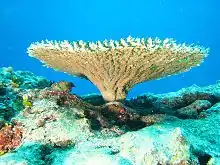Coral bleaching
Coral bleaching occurs when coral polyps expel algae that live inside their tissues. Normally, coral polyps live in an endosymbiotic relationship with these algae, which are crucial for the health of the coral and the reef.[1] The algae provides up to 90 percent of the coral's energy. Bleached corals continue to live but begin to starve after bleaching.[2] Some corals recover.
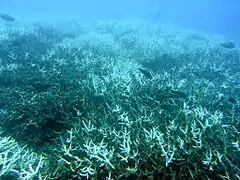

The leading cause of coral bleaching is rising water temperatures.[3] A temperature about 1 °C (or 2 °F) above average can cause bleaching.[3] According to the United Nations Environment Programme, between 2014 and 2016 the longest recorded global bleaching events killed coral on an unprecedented scale. In 2016, bleaching of coral on the Great Barrier Reef killed between 29 and 50 percent of the reef's coral.[4][5][6] In 2017, the bleaching extended into the central region of the reef.[7][8] The average interval between bleaching events has halved between 1980 and 2016.[9]
Process
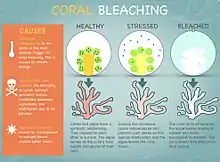
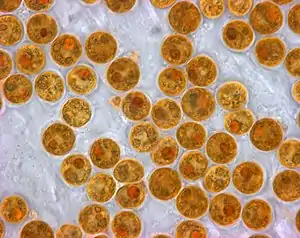
The corals that form the great reef ecosystems of tropical seas depend upon a symbiotic relationship with algae-like single-celled flagellate protozoa called zooxanthellae that live within their tissues and give the coral its coloration. The zooxanthellae provide the coral with nutrients through photosynthesis, a crucial factor in the clear and nutrient-poor tropical waters. In exchange, the coral provides the zooxanthellae with the carbon dioxide and ammonium needed for photosynthesis. Negative environmental conditions, such as abnormally warm or cool temperatures, high light, and even some microbial diseases, can lead to the breakdown of the coral/zooxanthellae symbiosis.[11] To ensure short-term survival, the coral-polyp then consumes or expels the zooxanthellae. This leads to a lighter or completely white appearance, hence the term "bleached".[12] As the zooxanthellae provide up to 90 percent of the coral's energy needs through products of photosynthesis, after expelling, the coral may begin to starve.
Coral can survive short-term disturbances, but if the conditions that lead to the expulsion of the zooxanthellae persist, the coral's chances of survival diminish. In order to recover from bleaching, the zooxanthellae have to re-enter the tissues of the coral polyps and restart photosynthesis to sustain the coral as a whole and the ecosystem that depends on it.[13] If the coral polyps die of starvation after bleaching, they will decay. The hard coral species will then leave behind their calcium carbonate skeletons, which will be taken over by algae, effectively blocking coral re-growth. Eventually, the coral skeletons will erode, causing the reef structure to collapse.
Triggers
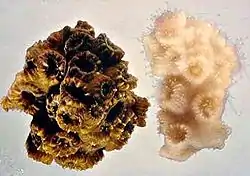
Coral bleaching may be caused by a number of factors. While localized triggers lead to localized bleaching, the large scale coral bleaching events of the recent years have been triggered by global warming. Under increased carbon dioxide concentration expected in the 21st century, corals are expected to becoming increasingly rare on reef systems.[14] Coral reefs located in warm, shallow water with low water flow have been more affected than reefs located in areas with higher water flow.[15]
List of triggers
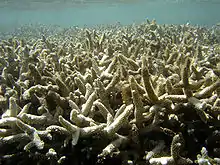
- increased water temperature (marine heatwaves, most commonly due to global warming), or reduced water temperatures[16][17][18][19]
- oxygen starvation caused by an increase in zooplankton levels as a result of overfishing[20]
- increased solar irradiance (photosynthetically active radiation and ultraviolet light)
- increased sedimentation (due to silt runoff)[21]
- bacterial infections[22]
- changes in salinity[23]
- herbicides[24]
- extreme low tide and exposure[25]
- cyanide fishing[26]
- elevated sea levels due to global warming (Watson)
- mineral dust from African dust storms caused by drought[27]
- pollutants such as oxybenzone, butylparaben, octyl methoxycinnamate, or enzacamene: four common sunscreen ingredients that are nonbiodegradable and can wash off of skin[28][29][30][31]
- ocean acidification due to elevated levels of CO2 caused by air pollution[32]
- being exposed to Oil or other chemical spills[33]
Mass bleaching events
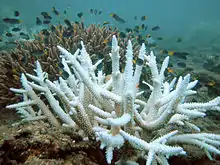
Elevated sea water temperatures are the main cause of mass bleaching events.[34] Sixty major episodes of coral bleaching have occurred between 1979 and 1990,[35][36] with the associated coral mortality affecting reefs in every part of the world. In 2016, the longest coral bleaching event was recorded.[37] The longest and most destructive coral bleaching event was because of the El Niño that occurred from 2014–2017.[38] During this time, over 70 percent of the coral reefs around the world have become damaged.[38]
Factors that influence the outcome of a bleaching event include stress-resistance which reduces bleaching, tolerance to the absence of zooxanthellae, and how quickly new coral grows to replace the dead. Due to the patchy nature of bleaching, local climatic conditions such as shade or a stream of cooler water can reduce bleaching incidence.[39] Coral and zooxanthellae health and genetics also influence bleaching.[39]
Large coral colonies such as Porites are able to withstand extreme temperature shocks, while fragile branching corals such Acropora are far more susceptible to stress following a temperature change.[40] Corals consistently exposed to low stress levels may be more resistant to bleaching.[41][42]
Scientists believe that the oldest known bleaching was that of the Late Devonian (Frasnian/Famennian), also triggered by the rise of sea surface temperatures. It resulted in the demise of the largest coral reefs in the Earth's history.[43]
According to Clive Wilkinson of Global Coral Reef Monitoring Network of Townsville, Australia, in 1998 the mass bleaching event that occurred in the Indian Ocean region was due to the rising of sea temperatures by 2 °C coupled with the strong El Niño event in 1997–1998.
Impact
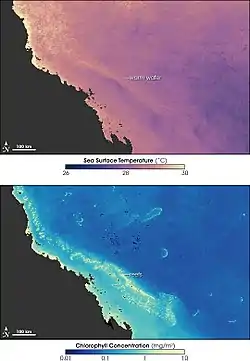
In the 2012–2040 period, coral reefs are expected to experience more frequent bleaching events. The Intergovernmental Panel on Climate Change (IPCC) sees this as the greatest threat to the world's reef systems.[44][45][46][47] During this period, 19 percent of coral reefs worldwide were lost, and 60 percent of the remaining reefs are at immediate risk of being lost. There are a couple of ways to discern the impact of coral bleaching on reefs: coral cover (the more coral that is covering the ground, the less of an impact bleaching had) and coral abundance (the number of different living species on the coral reef). With the increase of coral bleaching events worldwide, National Geographic noted in 2017, "In the past three years, 25 reefs—which comprise three-fourths of the world's reef systems—experienced severe bleaching events in what scientists concluded was the worst-ever sequence of bleachings to date."[48]
Coral bleaching events and the subsequent loss of coral coverage often result in the decline of fish diversity. The loss of diversity and abundance in herbivorous fish particularly affect coral reef ecosystems.[49] As mass bleaching events occur more frequently, fish populations will continue to homogenize. Smaller and more specialized fish species that fill particular ecological niches that are crucial for coral health are replaced by more generalized species. The loss of specialization likely to contributes to loss of resilience in coral reef ecosystems after bleaching events.[50]
Pacific Ocean
.jpg.webp)
Great Barrier Reef
The Great Barrier Reef along the coast of Australia experienced bleaching events in 1980, 1982, 1992, 1994, 1998, 2002, 2006, 2016 and 2017.[47][51] Some locations suffered severe damage, with up to 90% mortality.[52] The most widespread and intense events occurred in the summers of 1998 and 2002, with 42% and 54%, respectively, of reefs bleached to some extent, and 18% strongly bleached.[53][54] However, coral losses on the reef between 1995 and 2009 were largely offset by growth of new corals.[55] An overall analysis of coral loss found that coral populations on the Great Barrier Reef had declined by 50.7% from 1985 to 2012, but with only about 10% of that decline attributable to bleaching, and the remaining 90% caused about equally by tropical cyclones and by predation by crown-of-thorns starfishes.[56] A global mass coral bleaching has been occurring since 2014 because of the highest recorded temperatures plaguing oceans. These temperatures have caused the most severe and widespread coral bleaching ever recorded in the Great Barrier reef. The most severe bleaching in 2016 occurred near Port Douglas. In late November 2016 surveys of 62 reefs showed that long term heat stress from climate change caused a 29% loss of shallow water coral. The highest coral death and reef habitat loss was inshore and mid-shelf reefs around Cape Grenville and Princess Charlotte Bay.[57] The IPCC's moderate warming scenarios (B1 to A1T, 2 °C by 2100, IPCC, 2007, Table SPM.3, p. 13[58]) forecast that corals on the Great Barrier Reef are very likely to regularly experience summer temperatures high enough to induce bleaching.[53]
Hawaii
In 1996, Hawaii's first major coral bleaching occurred in Kaneohe Bay, followed by major bleaching events in the Northwest islands in 2002 and 2004.[59] In 2014, biologists from the University of Queensland observed the first mass bleaching event, and attributed it to The Blob.[60] In 2014 and 2015, a survey in Hanauma Bay Nature Preserve on Oahu found 47% of the corals suffering from coral bleaching and close to 10% of the corals dying.[61] In 2014 and 2015, 56% of the coral reefs of the big island were affected by coral bleaching events. During the same period, 44% of the corals on west Maui were effected.[62] On 24 January 2019, scientists with The Nature Conservancy found that the reefs had begun to stabilize nearly 4 years after the last bleaching event.[63] According to the Division of Aquatic Resources (DAR), there was still a considerable amount of bleaching in 2019. On Oahu and Maui, up to 50% of the coral reefs were bleached. On the big island, roughly 40% of corals experienced bleaching in the Kona Coast area. The DAR stated that the recent bleaching events have not been as bad as the 2014-2015 events.[64] In 2020, the National Oceanic and Atmospheric Administration (NOAA) released the first-ever nationwide coral reef status report. The report stated that the northwestern and main Hawaiian islands were in "fair" shape, meaning the corals have been moderately impacted. [65]
Jarvis Island
Eight severe and two moderate bleaching events occurred between 1960 and 2016 in the coral community in Jarvis Island, with the 2015–16 bleaching displaying the unprecedented severity in the record.[66]
Japan
According to the 2017 Japanese government report, almost 75% of Japan's largest coral reef in Okinawa has died from bleaching.[67]
Indian Ocean
Coral reef provinces have been permanently damaged by warm sea temperatures, most severely in the Indian Ocean. Up to 90% of coral cover has been lost in the Maldives, Sri Lanka, Kenya and Tanzania and in the Seychelles during the massive 1997–98 bleaching event. The Indian Ocean in 1998 reported 20% of its coral had died and 80% was bleached.[3] The shallow tropical areas of the Indian Ocean are already experiencing what are predicted to be worldwide ocean conditions in the future. Coral that has survived in the shallow areas of the Indian Ocean may be proper candidates for coral restoration efforts in other areas of the world because they are able to survive the extreme conditions of the ocean.[68]
Maldives
The Maldives has over 20,000 km2 of reefs, of which more than 60% of the coral has suffered from bleaching in 2016.[69][70]
Thailand
Thailand experienced a severe mass bleaching in 2010 which affected 70% of the coral in the Andaman Sea. Between 30% and 95% of the bleached coral died.[71]
Indonesia
In 2017 there was a study done on two islands in Indonesia to see how their coral cover was. One of the places was Melinjo Islands and the other was Saktu Islands. In Saktu Island the lifeform conditions were categorized as bad, with an average coral cover of 22.3%. In Melinjo Islands the lifeform conditions were categorized as bad, with an average coral cover of 22.2%.
United States
In South Florida, a 2016 survey of large corals from Key Biscayne to Fort Lauderdale found that about 66% of the corals were dead or reduced to less than half of their live tissue.[72]
Belize
The first recorded mass bleaching event that took place in the Belize Barrier Reef was in 1998, where sea level temperatures reached up to 31.5 °C (88.7 °F) from 10 August to 14 October. For a few days, Hurricane Mitch brought in stormy weather on 27 October but only reduced temperatures by 1 degree or less. During this time period, mass bleaching in the fore-reef and lagoon occurred. While some fore reef colonies suffered some damage, coral mortality in the lagoon was catastrophic.
The most prevalent coral in the reefs Belize in 1998 was the lettuce coral, Agaricia tenuifolia. On 22 and 23 October, surveys were conducted at two sites and the findings were devastating. Virtually all the living coral was bleached white and their skeletons indicated that they had died recently. At the lagoon floor, complete bleaching was evident among A. tenuifolia. Furthermore, surveys done in 1999 and 2000 showed a near total mortality of A. tenuifolia at all depths. Similar patterns occurred in other coral species as well. Measurements on water turbidity suggest that these mortalities were attributed to rising water temperatures rather than solar radiation.
Caribbean
Hard coral cover on reefs in the Caribbean have declined by an estimated 80%, from an average of 50% cover in the 1970s to only about 10% cover in the early 2000s.[73] A 2013 study to follow up on a mass bleaching event in Tobago from 2010 showed that after only one year, the majority of the dominant species declined by about 62% while coral abundance declined by about 50%. However, between 2011 and 2013, coral cover increased for 10 of the 26 dominant species but declined for 5 other populations.[74]
Other areas
Coral in the south Red Sea does not bleach despite summer water temperatures up to 34 °C (93 °F).[41][75] Coral bleaching in the Red Sea is more common in the northern section of the reefs, the southern part of the reef has been plagued by coral eating starfish, dynamite fishing and human impacts on the environment. In 1988 there was a massive bleaching event that affected the reefs in Saudi Arabia and in Sudan, the southern reefs were more resilient and affected them very little. Previously it was thought that the North suffers more from coral bleaching but they show a fast turnover of coral and the southern reef was thought to not suffer from bleaching as harshly, they show more consistency. However, new research shows where the south reef should be bigger and healthier than the north it was not. This is believed to be because of major disturbances in recent history from bleaching events, and coral eating starfish.[76] In 2010, coral bleaching occurred in Saudi Arabia and Sudan, where the temperature rose 10 to 11 degrees. Certain taxa experienced 80% to 100% of their colonies bleaching, while some showed on average 20% of that taxa bleaching.[77]
Economic and political impact
According to Brian Skoloff of The Christian Science Monitor, "If the reefs vanished, experts say, hunger, poverty and political instability could ensue."[78] Since countless sea life depend on the reefs for shelter and protection from predators, the extinction of the reefs would ultimately create a domino effect that would trickle down to the many human societies that depend on those fish for food and livelihood. There has been a 44% decline over the last 20 years in the Florida Keys, and up to 80% in the Caribbean alone.[79]
Coral reefs provide various ecosystem services, one of which is being a natural fishery, as many frequently consumed commercial fish spawn or live out their juvenile lives in coral reefs around the tropics.[80][81][82] Thus, reefs are a popular fishing site and are an important source of income for fishers, especially small, local fisheries.[82] As coral reef habitat decreases due to bleaching, reef associated fish populations also decrease, which affects fishing opportunities.[80] A model from one study by Speers et al. calculated direct losses to fisheries from decreased coral cover to be around $49–69 billion, if human societies continue to emit high levels of greenhouse gases.[80] But, these losses could be reduced for a consumer surplus benefit of about $14–20 billion, if societies chose to emit a lower level of greenhouse gases instead.[80] These economic losses also have important political implications, as they fall disproportionately on developing countries where the reefs are located, namely in Southeast Asia and around the Indian Ocean.[80][82][83] It would cost more for countries in these areas to respond to coral reef loss as they would need to turn to different sources of income and food, in addition to losing other ecosystem services such as ecotourism.[81][83] A study completed by Chen et al. suggested that the commercial value of reefs decreases by almost 4% every time coral cover decreases by 1% because of losses in ecotourism and other potential outdoor recreational activities.[81]
Coral reefs also act as a protective barrier for coastlines by reducing wave impact, which lowers the damage from storms, erosions, and flooding. Countries that lose this natural protection will lose more money because of the increased susceptibility of storms. This indirect cost, combined with the lost revenue in tourism, will result in enormous economic effects.[12]
Monitoring reef sea surface temperature
The US National Oceanic and Atmospheric Administration (NOAA) monitors for bleaching "hot spots", areas where sea surface temperature rises 1 °C or more above the long-term monthly average. The "hot spots" are the location in which thermal stress is measured and with the development of Degree Heating Week (DHW), the coral reef's thermal stress is monitored.[84][85] Global coral bleaching is being detected earlier due to the satellite remote sensing the rise of sea temperatures.[84][86] It is necessary to monitor the high temperatures because coral bleaching events are affecting coral reef reproduction and normal growth capacity, as well as it weakening corals, eventually leading to their mortality.[86] This system detected the worldwide 1998 bleaching event,[87][88] that corresponded to the 1997–98 El Niño event.[89] Currently, 190 reef sites around the globe are monitored by the NOAA, and send alerts to research scientists and reef managers via NOAA Coral Reef Watch (CRW) website.[90] By monitoring the warming of sea temperatures, the early warnings of coral bleaching, alerts reef managers to prepare and draw awareness to future bleaching events.[90] The first mass global bleaching events were recorded in 1998 and 2010, which was when the El Niño caused the oceans temperatures to rise and worsened the corals living conditions.[38] The 2014–2017 El Niño was recorded to be the longest and most damaging to the corals, which harmed over 70% of our coral reefs.[38] Over two thirds of the Great Barrier Reef have been reported to be bleached or dead.[38]
Changes in ocean chemistry
Increasing ocean acidification due to rises in carbon dioxide levels exacerbates the bleaching effects of thermal stress. Acidification affects the corals' ability to create calcareous skeletons, essential to their survival.[91] This is because ocean acidification decreases the amount of carbonate ion in the water, making it more difficult for corals to absorb the calcium carbonate they need for the skeleton. As a result, the resilience of reefs goes down, while it becomes easier for them to erode and dissolve.[92] In addition, the increase in CO2 allows herbivore overfishing and nutrification to change coral-dominated ecosystems to algal-dominated ecosystems.[93] A recent study from the Atkinson Center for a Sustainable Future found that with the combination of acidification and temperature rises, the levels of CO2 could become too high for coral to survive in as little as 50 years.[91]
Coral Bleaching Due to Photoinhibition of Zooxanthellae
Zooxanthellae are a type of dinoflagellate that live within the cytoplasm of many marine invertebrates.[94] Members of the phylum Dinoflagellata, they are a round micro-algae that are share a symbiotic relationship with their host. They are also part of the genus Symbiodinium and Kingdom Alveolata. These organisms are phytoplankton and therefore photosynthesize. The products of photosynthesis, ie. oxygen, sugar, etc. are harnessed by the host organism, and in exchange, the zooxanthellae are offered housing and protection, as well as carbon dioxide, phosphates and other essential inorganic compounds that help them to survive and thrive. Zooxanthellae share 95% of the products of photosynthesis with their host coral.[95] According to the a study done by D.J. Smith et al. photoinhibition is a likely factor in coral bleaching.[96] It also suggests that the hydrogen peroxide produced in zooxanthealle plays a role in signaling themselves to flee the corals. Photo-inhibition of Zooxanthellae can be caused by exposure to UV filters found in personal care products. [97] In a study done by Zhong et al., Oxybenzone (BP-3) had the most negative effects on zooxanthellae health. The combination of temperature increase and presence of UV filters in the ocean has further decreased zooxanthellae health.[98] The combination of UV filters and higher temperatures led to an additive effect on photo-inihibition and overall stress on coral species.[99]
Infectious disease
Infectious bacteria of the species Vibrio shiloi are the bleaching agent of Oculina patagonica in the Mediterranean Sea, causing this effect by attacking the zooxanthellae.[100][101][102] V. shiloi is infectious only during warm periods. Elevated temperature increases the virulence of V. shiloi, which then become able to adhere to a beta-galactoside-containing receptor in the surface mucus of the host coral.[101][103] V. shiloi then penetrates the coral's epidermis, multiplies, and produces both heat-stable and heat-sensitive toxins, which affect zooxanthellae by inhibiting photosynthesis and causing lysis.
During the summer of 2003, coral reefs in the Mediterranean Sea appeared to gain resistance to the pathogen, and further infection was not observed.[104] The main hypothesis for the emerged resistance is the presence of symbiotic communities of protective bacteria living in the corals. The bacterial species capable of lysing V. shiloi had not been identified as of 2011.
Coral adaptation
In 2010, researchers at Penn State discovered corals that were thriving while using an unusual species of symbiotic algae in the warm waters of the Andaman Sea in the Indian Ocean. Normal zooxanthellae cannot withstand temperatures as high as was there, so this finding was unexpected. This gives researchers hope that with rising temperatures due to global warming, coral reefs will develop tolerance for different species of symbiotic algae that are resistant to high temperature, and can live within the reefs.[105][106] In 2010, researchers from Stanford University also found corals around the Samoan Islands that experience a drastic temperature increase for about four hours a day during low tide. The corals do not bleach or die regardless of the high heat increase. Studies showed that the corals off the coast of Ofu Island near America Samoa have become trained to withstand the high temperatures. Researchers are now asking a new question: can we condition corals, that are not from this area, in this manner and slowly introduce them to higher temperatures for short periods of time and make them more resilient against rising ocean temperatures.[107]
Recovery and macroalgal regime shifts
After corals experience a bleaching event to increased temperature stress some reefs are able to return to their original, pre-bleaching state.[108][109] Reefs either recover from bleaching, where they are recolonized by zooxanthellae, or they experience a regime shift, where previously flourishing coral reefs are taken over by thick layers of macroalgae.[110] This inhibits further coral growth because the algae produces antifouling compounds to deter settlement and competes with corals for space and light. As a result, macroalgae forms stable communities that make it difficult for corals to grow again. Reefs will then be more susceptible to other issues, such as declining water quality and removal of herbivore fish, because coral growth is weaker.[14] Discovering what causes reefs to be resilient or recover from bleaching events is of primary importance because it helps inform conservation efforts and protect coral more effectively.
A primary subject of research regarding coral recovery pertains to the idea of super-corals, otherwise referred to as the corals that live and thrive in naturally warmer and more acidic regions and bodies of water. When transplanted to endangered or bleached reefs, their resilience and irradiance can equip the algae to live among the bleached corals. As Emma Camp,[111] a National Geographic Explorer, marine bio-geochemist and an ambassador for Biodiversity for the charity IBEX Earth, suggests, the super-corals could have the capability to help with the damaged reefs long-term. While it can take 10 to 15 years to restore damaged and bleached coral reefs,[112] the super-corals could have lasting impacts despite climate change as the oceans rise in temperature and gain more acidity. Bolstered by the research of Ruth Gates, Camp has looked into lower oxygen levels and the extreme, unexpected habitats that reefs can be found in across the globe.
Corals have shown to be resilient to short-term disturbances. Recovery has been shown in after storm disturbance and crown of thorns starfish invasions.[108] Fish species tend to fare better following reef disturbance than coral species as corals show limited recovery and reef fish assemblages have shown little change as a result of short-term disturbances.[108] In contrast, fish assemblages in reefs that experience bleaching exhibit potentially damaging changes. One study by Bellwood et al. notes that while species richness, diversity, and abundance did not change, fish assemblages contained more generalist species and less coral dependent species.[108] Responses to coral bleaching are diverse between reef fish species, based on what resources are affected.[113] Rising sea temperature and coral bleaching do not directly impact adult fish mortality, but there are many indirect consequences of both.[113] Coral-associated fish populations tend to be in decline due to habitat loss; however, some herbivorous fish populations have seen a drastic increase due to the increase of algae colonization on dead coral.[113] Studies note that better methods are needed to measure the effects of disturbance on the resilience of corals.[108][114]
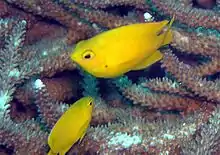
Until recently, the factors mediating the recovery of coral reefs from bleaching were not well studied. Research by Graham et al. (2005) studied 21 reefs around Seychelles in the Indo-Pacific in order to document the long-term effects of coral bleaching.[109] After the loss of more than 90% of corals due to bleaching in 1998 around 50% of the reefs recovered and roughly 40% of the reefs experienced regime shifts to macroalgae dominated compositions.[109] After an assessment of factors influencing the probability of recovery, the study identified five major factors: density of juvenile corals, initial structural complexity, water depth, biomass of herbivorous fishes, and nutrient conditions on the reef.[109] Overall, resilience was seen most in coral reef systems that were structurally complex and in deeper water.[109]
The ecological roles and functional groups of species also play a role in the recovery of regime shifting potential in reef systems. Coral reefs are affected by bioeroding, scraping, and grazing fish species. Bioeroding species remove dead corals, scraping species remove algae and sediment to further future growth, grazing species remove algae.[116] The presence of each type of species can influence the ability for normal levels of coral recruitment which is an important part of coral recovery.[116] Lowered numbers of grazing species after coral bleaching in the Caribbean has been likened to sea-urchin-dominated systems which do not undergo regime shifts to fleshy macroalgae dominated conditions.[110]
There is always the possibility of unobservable changes, or cryptic losses or resilience, in a coral community's ability to perform ecological processes.[108][116] These cryptic losses can result in unforeseen regime changes or ecological flips.[108] More detailed methods for determining the health of coral reefs that take into account long-term changes to the coral ecosystems and better-informed conservation policies are necessary to protect coral reefs in the years to come.[108][109][114][116]
Rebuilding coral reefs
Research is being done to help slow down the mortality rate of corals. Worldwide projects are being completed to help replenish and restore the coral reefs. Current coral restoration efforts include microfragmentation, coral farming, and relocation. The population of corals is rapidly declining, so scientists are doing experiments in coral growth and research tanks to help replenish the population of corals.[38] These research tanks mimic the coral reefs natural environment in the ocean.[38] They are growing corals in these tanks to use for their experiments, so no more corals are being harmed or taken from the ocean.[38] They are also transplanting the successfully grown corals from the research tanks and putting them into the areas of the ocean where the reefs are dying out.[38] An experiment is being done in some coral growth and research tanks by Ruth Gates and Madelaine Van Oppen.[38] They are trying to make "super corals" that can withstand some of the environmental factors that the corals are currently dying from.[38] Van Oppen is also working on developing a type of algae that will have a symbiotic relationship with corals and can withstand water temperature fluctuations for long periods of time.[38] This project may be helping to replenish our reefs, but the growing process of corals in research tanks is very time-consuming.[38] It can take at least 10 years for the corals to fully grow and mature enough to where they will be able to breed.[38] Following Ruth Gates' death in October 2018, her team at the Gates Coral Lab at the Hawai'i Institute of Marine Biology continues her research on restoration efforts. Continuing research and restoration efforts at the Gates Coral Lab focuses on the effects of beneficial mutations, genetic variation, and relocation via human assistance on the resilience of coral reefs.[117][118] As of 2019, the Gates Coral Lab team determined that large-scale restoration techniques would not be effective; localized efforts to restore coral reefs on an individual basis are tested to be more realistic and effective while research is conducted to determine the best ways to combat coral destruction on a mass scale.[119]
Economic value of coral reefs
Coral reefs provide shelter to an estimated quarter of all ocean species.[120] Experts estimate that coral reef services are worth up to $1.2 million per hectare which translates to an average of $172 billion per year.[121] The benefits of coral reefs include providing physical structures such as coastal shoreline protection, biotic services within and between ecosystems, biogeochemical services such as maintaining nitrogen levels in the ocean, climate records, and recreational and commercial (tourism) services.[122] Coral reefs are one of the best marine ecosystems to use to as a food source.[33] The coral reefs are also the perfect habitat for rare and economically important species of tropical fish, as they provide the perfect area for fish to breed and create nurseries in.[33] If the populations of the fish and corals in the reef are high, then we can use the area as a place to gather food and things with medicinal properties, which also helps create jobs for people who can collect these specimens.[33] The reefs also have some cultural importance in specific regions around the world.[33]
Cost benefit analysis of reducing loss of coral reefs
In 2010, the Convention on Biological Diversity's (CBD) Strategic Plan for Biodiversity 2011–2020 created twenty distinct targets for sustainable development for post-2015. Target 10 indicates the goal of minimizing "anthropogenic pressures on coral reefs".[123] Two programs were looked at, one that reduces coral reef loss by 50% that has a capital cost of $684 million and a recurrent cost of $81 million. The other program reduces coral reef loss by 80 percent and has a capital cost of $1.036 million with recurring costs of $130 million. CBD acknowledges that they may be underestimating the costs and resources needed to achieve this target due to lack of relevant data but nonetheless, the cost-benefit analysis shows that the benefits outweigh the costs by a great enough amount for both programs (benefit cost ratio of 95.3 and 98.5) that "there is ample scope to increase outlays on coral protection and still achieve a benefit to cost ratio that is well over one".[123]
Notes
- Dove SG, Hoegh-Guldberg O (2006). "Coral bleaching can be caused by stress. The cell physiology of coral bleaching". In Ove Hoegh-Guldberg, Jonathan T. Phinney, William Skirving, Joanie Kleypas (eds.). Coral Reefs and Climate Change: Science and Management. [Washington]: American Geophysical Union. pp. 1–18. ISBN 978-0-87590-359-0.
- "The Great Barrier Reef: a catastrophe laid bare". The Guardian. 6 June 2016.
- "Corals and Coral Reefs". Smithsonian Ocean. Retrieved 15 August 2019.
- "Coral bleaching on Great Barrier Reef worse than expected, surveys show". The Guardian. 29 May 2017. Retrieved 29 May 2017.
- "The United Nations just released a warning that the Great Barrier Reef is dying". The Independent. 3 June 2017. Retrieved 11 June 2017.
- Hughes TP, Kerry JT, Álvarez-Noriega M, Álvarez-Romero JG, Anderson KD, Baird AH, et al. (March 2017). "Global warming and recurrent mass bleaching of corals" (PDF). Nature. 543 (7645): 373–377. Bibcode:2017Natur.543..373H. doi:10.1038/nature21707. PMID 28300113.
- "Mass coral bleaching hits the Great Barrier Reef for the second year in a row". USA TODAY. 13 March 2017. Retrieved 14 March 2017.
- Galimberti, Katy (18 April 2017). "Portion of Great Barrier Reef hit with back-to-back coral bleaching has 'zero prospect for recovery'". AccuWeather.com. Retrieved 18 April 2017.
When coral experiences abnormal conditions, it releases an algae called zooxanthellae. The loss of the colorful algae causes the coral to turn white.
- Hughes TP, Anderson KD, Connolly SR, Heron SF, Kerry JT, Lough JM, et al. (January 2018). "Spatial and temporal patterns of mass bleaching of corals in the Anthropocene" (PDF). Science. 359 (6371): 80–83. Bibcode:2018Sci...359...80H. doi:10.1126/science.aan8048. PMID 29302011.
- What is coral bleaching? NOAA National Ocean Service. Accessed: 10 January 2020. Updated 7 January 2020.
- Lesser, M.P. (2010). "Coral Bleaching: Causes and Mechanisms". In Dubinzk, Z.; Stambler, N. (eds.). Coral Reefs: An Ecosystem in Transition. Dordrecht: Springer. pp. 405–419. doi:10.1007/978-94-007-0114-4_23. ISBN 978-94-007-0114-4.
- Hoegh-Guldberg, Ove (1999). "Climate change, coral bleaching and the future of the world's coral reefs". Marine and Freshwater Research. 50 (8): 839–66. doi:10.1071/MF99078.
- Nir O, Gruber DF, Shemesh E, Glasser E, Tchernov D (15 January 2014). "Seasonal mesophotic coral bleaching of Stylophora pistillata in the Northern Red Sea". PLOS ONE. 9 (1): e84968. Bibcode:2014PLoSO...984968N. doi:10.1371/journal.pone.0084968. PMC 3893136. PMID 24454772.
- Hoegh-Guldberg O, Mumby PJ, Hooten AJ, Steneck RS, Greenfield P, Gomez E, et al. (December 2007). "Coral reefs under rapid climate change and ocean acidification". Science. 318 (5857): 1737–42. Bibcode:2007Sci...318.1737H. CiteSeerX 10.1.1.702.1733. doi:10.1126/science.1152509. PMID 18079392.
- Baker A, Glynn P, Riegl B (2008). "Climate change and coral reef bleaching: An ecological assessment of long-term impacts, recovery trends and future outlook". Estuarine, Coastal and Shelf Science. 80 (4): 435–471. Bibcode:2008ECSS...80..435B. doi:10.1016/j.ecss.2008.09.003.
- "Reef 'at risk in climate change'" (Press release). The University of Queensland. 6 April 2007. Retrieved 2 August 2016.
- Anthony, K. 2007; Berkelmans
- Saxby T, Dennison WC, Hoegh-Guldberg O (2003). "Photosynthetic responses of the coral Montipora digitata to cold temperature stress". Marine Ecology Progress Series. 248: 85–97. Bibcode:2003MEPS..248...85S. doi:10.3354/meps248085.
- Marimuthu N, Jerald Wilson J, Vinithkumar NV, Kirubagaran R (9 November 2012). "Coral reef recovery status in south Andaman Islands after the bleaching event 2010". Journal of Ocean University of China. 12 (1): 91–96. Bibcode:2013JOUC...12...91M. doi:10.1007/s11802-013-2014-2.
- "Mass Coral Bleaching". fisherycrisis.com.
- Rogers CS (1990). "Responses of coral reefs and reef organisms to sedimentation". Marine Ecology Progress Series. 62: 185–202. Bibcode:1990MEPS...62..185R. doi:10.3354/meps062185.
- Kushmaro A, Rosenberg E, Fine M, Loya Y (1997). "Bleaching of the coral Oculina patagonica by Vibrio AK-1". Marine Ecology Progress Series. 147: 159–65. Bibcode:1997MEPS..147..159K. doi:10.3354/meps147159.
- Hoegh-Guldberg O, Smith G (1989). "The effect of sudden changes in temperature, light and salinity on the population density and export of zooxanthellae from the reef corals Stylophora pistillata Esper and Seriatopora hystrix Dana". Journal of Experimental Marine Biology and Ecology. 129 (3): 279–303. doi:10.1016/0022-0981(89)90109-3.
- Jones RJ, Muller J, Haynes D, Schreiber U (2003). "Effects of herbicides diuron and atrazine on corals of the Great Barrier Reef, Australia". Marine Ecology Progress Series. 251: 153–167. Bibcode:2003MEPS..251..153J. doi:10.3354/meps251153.
- Anthony KR, Kerswell AP (2007). "Coral mortality following extreme low tides and high solar radiation". Marine Biology. 151 (5): 1623–31. doi:10.1007/s00227-006-0573-0.
- Jones RJ, Hoegh-Guldberg O (1999). "Effects of cyanide on coral photosynthesis:implications for identifying the cause of coral bleaching and for assessing the environmental effects of cyanide fishing". Marine Ecology Progress Series. 177: 83–91. Bibcode:1999MEPS..177...83J. doi:10.3354/meps177083.
- U. S. Geological Survey. Coral Mortality and African Dust. Retrieved on 10 June 2007.
- "Protect Yourself, Protect The Reef! The impacts of sunscreens on our coral reefs" (PDF). U.S. National Park Service. Retrieved 1 July 2013.
- "Coral Reef Safe Sunscreen". badgerbalm.com.
- Danovaro R, Bongiorni L, Corinaldesi C, Giovannelli D, Damiani E, Astolfi P, Greci L, Pusceddu A (April 2008). "Sunscreens cause coral bleaching by promoting viral infections". Environmental Health Perspectives. 116 (4): 441–7. doi:10.1289/ehp.10966. PMC 2291018. PMID 18414624.
- Downs CA, Kramarsky-Winter E, Fauth JE, Segal R, Bronstein O, Jeger R, Lichtenfeld Y, Woodley CM, Pennington P, Kushmaro A, Loya Y (March 2014). "Toxicological effects of the sunscreen UV filter, benzophenone-2, on planulae and in vitro cells of the coral, Stylophora pistillata". Ecotoxicology. 23 (2): 175–91. doi:10.1007/s10646-013-1161-y. PMID 24352829.
- Anthony KR, Kline DI, Diaz-Pulido G, Dove S, Hoegh-Guldberg O (November 2008). "Ocean acidification causes bleaching and productivity loss in coral reef builders". Proceedings of the National Academy of Sciences of the United States of America. 105 (45): 17442–6. Bibcode:2008PNAS..10517442A. doi:10.1073/pnas.0804478105. PMC 2580748. PMID 18988740.
- "How Do Oil Spills Affect Coral Reefs?". response.restoration.noaa.gov. Retrieved 24 April 2018.
- Baker AC, Glynn PW, Riegl B (2008). "Climate change and coral reef bleaching: An ecological assessment of long-term impacts, recovery trends and future outlook". Estuarine, Coastal and Shelf Science. 80 (4): 435–71. Bibcode:2008ECSS...80..435B. doi:10.1016/j.ecss.2008.09.003.
- Chumkiew S, Jaroensutasinee M, Jaroensutasinee K (2011). "Impact of Global Warming on Coral Reefs". Walailak Journal of Science and Technology. 8 (2): 111–29.
- Huppert A, Stone L (September 1998). "Chaos in the Pacific's coral reef bleaching cycle". The American Naturalist. 152 (3): 447–59. doi:10.1086/286181. PMID 18811451.
- McDermott, Amy (22 June 2016). "Coral bleaching event is longest on record". Science News. Retrieved 25 July 2016.
- Albright R (December 2017). "Can We Save the Corals?". Scientific American. 318 (1): 42–49. Bibcode:2017SciAm.318a..42A. doi:10.1038/scientificamerican0118-42. PMID 29257818.
- Marshall P, Schuttenberg H (2006). A Reef Manager's Guide to Coral Bleaching (PDF). Townsville, Australia: Great Barrier Reef Marine Park Authority. pp. 78–79. ISBN 978-1-876945-40-4.
- Baird and Marshall 2002
- Gabriel D. Grinmsditch and Rodney V. Salm, Coral Reef Resilience and Resistance to Bleaching, "IUCN: The World Conservation Union", 2006
- Iguchi A, Ozaki S, Nakamura T, Inoue M, Tanaka Y, Suzuki A, Kawahata H, Sakai K (February 2012). "Effects of acidified seawater on coral calcification and symbiotic algae on the massive coral Porites australiensis". Marine Environmental Research. 73: 32–6. doi:10.1016/j.marenvres.2011.10.008. PMID 22115919.
- Zapalski MK, Nowicki J, Jakubowicz M, Berkowski B (2017). "Tabulate corals across the Frasnian/Famennian boundary: architectural turnover and its possible relation to ancient photosymbiosis". Palaeogeography, Palaeoclimatology, Palaeoecology. 487: 416–429. Bibcode:2017PPP...487..416Z. doi:10.1016/j.palaeo.2017.09.028.
- IPCC (2007). "Summary for policymakers" (PDF). In Parry ML, Canziani OF, Palutikof JP, van der Linden PJ, Hanson CE (eds.). Climate Change 2007: impacts, adaptation and vulnerability: contribution of Working Group II to the fourth assessment report of the Intergovernmental Panel on Climate Change. Cambridge, UK: Cambridge University Press. pp. 7–22. ISBN 978-0-521-70597-4.
- Fischlin A, Midgley GF, Price JT, Leemans R, Gopal B, Turley C, Rounsevell MD, Dube OP, Tarazona J, Velichko AA (2007). "Ch 4. Ecosystems, their properties, goods and services" (PDF). In Parry ML, Canziani OF, Palutikof JP, van der Linden PJ, Hanson CE (eds.). Climate Change 2007: impacts, adaptation and vulnerability: contribution of Working Group II to the fourth assessment report of the Intergovernmental Panel on Climate Change. Cambridge, UK: Cambridge University Press. pp. 211–72. ISBN 978-0-521-70597-4.
- Nicholls RJ, Wong PP, Burkett V, Codignotto J, Hay J, McLean R, Ragoonaden S, Woodroffe CD (2007). "Ch 6. Coastal systems and low-lying areas" (PDF). In Parry ML, Canziani OF, Palutikof JP, van der Linden PJ, Hanson CE (eds.). Climate Change 2007: impacts, adaptation and vulnerability: contribution of Working Group II to the fourth assessment report of the Intergovernmental Panel on Climate Change. Cambridge, UK: Cambridge University Press. pp. 315–57. ISBN 978-0-521-70597-4.
- Hennessy K, Fitzharris B, Bates BC, Harvey N, Howden M, Hughes L, Salinger J, Warrick R (2007). "Ch 11. Australia and New Zealand" (PDF). In Parry ML, Canziani OF, Palutikof JP, van der Linden PJ, Hanson CE (eds.). Climate Change 2007: impacts, adaptation and vulnerability: contribution of Working Group II to the fourth assessment report of the Intergovernmental Panel on Climate Change. Cambridge, UK: Cambridge University Press. pp. 507–40. ISBN 978-0-521-70597-4.
- "Coral Reefs Could Be Gone in 30 Years". National Geographic News. 23 June 2017. Retrieved 7 May 2019.
- Pratchett, M. S., Hoey, A. S., Wilson, S. K., Messmer, V., & Graham, N. A. (2011). Changes in biodiversity and functioning of reef fish assemblages following coral bleaching and coral loss. Diversity, 3(3), 424-452.
- "The Hidden Coral Crisis: Loss of Fish Diversity After Bleaching Strikes". Oceans. Retrieved 2 July 2020.
- Plumer, Brad (31 March 2016). "The unprecedented coral bleaching disaster at the Great Barrier Reef, explained". Vox Energy & Environment.
- Johnson JE, Marshall PA (2007). Climate change and the Great Barrier Reef: a vulnerability assessment. Townsville, Qld.: Great Barrier Reef Marine Park Authority. ISBN 978-1-876945-61-9. Archived from the original on 25 January 2014.
- Done T, Whetton P, Jones R, Berkelmans R, Lough J, Skirving W, Wooldridge S (2003). Global Climate Change and Coral Bleaching on the Great Barrier Reef (PDF). Queensland Government Department of Natural Resources and Mines. ISBN 978-0-642-32220-3. Archived from the original (PDF) on 27 September 2011.
- Berkelmans R, De'ath G, Kininmonth S, Skirving WJ (2004). "A comparison of the 1998 and 2002 coral bleaching events on the Great Barrier Reef: spatial correlation, patterns, and predictions". Coral Reefs. 23 (1): 74–83. doi:10.1007/s00338-003-0353-y.
- Osborne K, Dolman AM, Burgess SC, Johns KA (March 2011). "Disturbance and the dynamics of coral cover on the Great Barrier Reef (1995–2009)". PLOS ONE. 6 (3): e17516. Bibcode:2011PLoSO...617516O. doi:10.1371/journal.pone.0017516. PMC 3053361. PMID 21423742.
- De'ath G, Fabricius KE, Sweatman H, Puotinen M (October 2012). "The 27-year decline of coral cover on the Great Barrier Reef and its causes". Proceedings of the National Academy of Sciences of the United States of America. 109 (44): 17995–9. Bibcode:2012PNAS..10917995D. doi:10.1073/pnas.1208909109. PMC 3497744. PMID 23027961.
- Final Report: 2016 Coral Bleaching Event on Great Barrier Reef . Great Barrier Reef Marine Park Authority Townsville, 2017, pp. 24–24, Final Report: 2016 Coral Bleaching Event on Great Barrier Reef .
- IPCC (2007). "Summary for policymakers" (PDF). In Solomon S, Qin D, Manning M, Chen Z, Marquis M, Averyt KB, Tignor M, Miller HL (eds.). Climate change 2007: The Physical Science Basis. Contribution of Working Group I to the Fourth Assessment Report of the Intergovernmental Panel on Climate Change. Cambridge, UK: Cambridge University Press. pp. 1–18.
- "Climate Change and Marine Disease". dlnr.hawaii.gov. Retrieved 15 August 2019.
- "Rapidly warming ocean a threat to Hawaiian coral reefs". The University of Queensland. 2015.
- "Corals in peril at a popular Hawaiian tourist destination due to global climate change". Retrieved 30 May 2017.
- Kahn, Brian (8 November 2017). "Coral Bleaching Has Ravaged Half of Hawaii's Coral Reefs". Gizmodo.
- "Hawaii coral reefs stabilizing following bleaching event". Associated Press. 24 January 2019. Retrieved 25 January 2019.
- "11/5/19 – CORAL BLEACHING NOT AS SEVERE AS PREDICTED BUT STILL WIDESPREAD; Extensive Surveys Show Bleaching Event Now Abating". dlnr.hawaii.gov. Retrieved 6 December 2020.
- Donovan, Caroline; Towle, Erica K.; Kelsey, Heath; Allen, Mary; Barkley, Hannah; Besemer, Nicole; Blondeau, Jeremiah; Eakin, Mark; Edwards, Kimberly; Enochs, Ian; Fleming, Chloe (2020). "Coral reef condition: A status report for U.S. coral reefs". doi:10.25923/wbbj-t585. Cite journal requires
|journal=(help) - Barkley, Hannah C.; Cohen, Anne L.; Mollica, Nathaniel R.; Brainard, Russell E.; Rivera, Hanny E.; DeCarlo, Thomas M.; Lohmann, George P.; Drenkard, Elizabeth J.; Alpert, Alice E. (8 November 2018). "Repeat bleaching of a central Pacific coral reef over the past six decades (1960–2016)". Communications Biology. 1 (1): 177. doi:10.1038/s42003-018-0183-7. hdl:1912/10707. ISSN 2399-3642. PMC 6224388. PMID 30417118.
- McCurry, Justin (11 January 2017). "Almost 75% of Japan's biggest coral reef has died from bleaching, says report". The Guardian. Retrieved 30 May 2017.
- Freeman, L. A., Kleypas, J. A., & Miller, A. J. (2013). Coral reef habitat response to climate change scenarios. PloS one, 8(12).
- Gischler, Eberhard; Storz, David; Schmitt, Dominik (April 2014). "Sizes, shapes, and patterns of coral reefs in the Maldives, Indian Ocean: the influence of wind, storms, and precipitation on a major tropical carbonate platform". Carbonates and Evaporites. 29 (1): 73–87. doi:10.1007/s13146-013-0176-z. ISSN 0891-2556.
- "More than 60% of Maldives' coral reefs hit by bleaching". The Guardian. 8 August 2016. Retrieved 31 May 2017.
- "As sea temperatures rise, Thailand sees coral bleeching". Bangkok Post. 25 December 2016.
- Fleshler, David (24 April 2016). "South Florida corals dying in "unprecedented" bleaching and disease". Sun-Sentinel.com.
- Smith JE, Brainard R, Carter A, Grillo S, Edwards C, Harris J, Lewis L, Obura D, Rohwer F, Sala E, Vroom PS, Sandin S (January 2016). "Re-evaluating the health of coral reef communities: baselines and evidence for human impacts across the central Pacific". Proceedings. Biological Sciences. 283 (1822): 20151985. doi:10.1098/rspb.2015.1985. PMC 4721084. PMID 26740615.
- Buglass S, Donner SD, Alemu I JB (March 2016). "A study on the recovery of Tobago's coral reefs following the 2010 mass bleaching event". Marine Pollution Bulletin. 104 (1–2): 198–206. doi:10.1016/j.marpolbul.2016.01.038. hdl:2429/51752. PMID 26856646.
- Alevizon, William. "Red Sea Coral Reefs". Coral Reef Facts. Archived from the original on 6 December 2016. Retrieved 27 February 2014.
- Riegl BM, Bruckner AW, Rowlands GP, Purkis SJ, Renaud P (31 May 2012). "Red Sea coral reef trajectories over 2 decades suggest increasing community homogenization and decline in coral size". PLOS ONE. 7 (5): e38396. Bibcode:2012PLoSO...738396R. doi:10.1371/journal.pone.0038396. PMC 3365012. PMID 22693620.
- Furby KA, Bouwmeester J, Berumen ML (4 January 2013). "Susceptibility of central Red Sea corals during a major bleaching event". Coral Reefs. 32 (2): 505–513. Bibcode:2013CorRe..32..505F. doi:10.1007/s00338-012-0998-5.
- Skoloff, Brian (26 March 2010) Death of coral reefs could devastate nations, The Christian Science Monitor
- "Endangered Coral Reefs Die as Ocean Temperatures Rise and Water Turns Acidic", PBS Newshour, 5 December 2012
- Speers AE, Besedin EY, Palardy JE, Moore C (1 August 2016). "Impacts of climate change and ocean acidification on coral reef fisheries: An integrated ecological–economic model". Ecological Economics. 128: 33–43. doi:10.1016/j.ecolecon.2016.04.012.
- Chen P, Chen C, Chu L, McCarl B (1 January 2015). "Evaluating the economic damage of climate change on global coral reefs". Global Environmental Change. 30: 12–20. doi:10.1016/j.gloenvcha.2014.10.011.
- Teh LS, Teh LC, Sumaila UR (19 June 2013). "A Global Estimate of the Number of Coral Reef Fishers". PLOS ONE. 8 (6): e65397. Bibcode:2013PLoSO...865397T. doi:10.1371/journal.pone.0065397. PMC 3686796. PMID 23840327.
- Wolff NH, Donner SD, Cao L, Iglesias-Prieto R, Sale PF, Mumby PJ (November 2015). "Global inequities between polluters and the polluted: climate change impacts on coral reefs". Global Change Biology. 21 (11): 3982–94. Bibcode:2015GCBio..21.3982W. doi:10.1111/gcb.13015. PMID 26234736.
- Liu G, Strong AE, Skirving W (15 April 2003). "Remote sensing of sea surface temperatures during 2002 Barrier Reef coral bleaching". Eos, Transactions American Geophysical Union. 84 (15): 137–141. Bibcode:2003EOSTr..84..137L. doi:10.1029/2003EO150001. S2CID 128559504.
- McClanahan TR, Ateweberhan M, Sebastián CR, Graham NJ, Wilson SK, Bruggemann JH, Guillaume MM (1 September 2007). "Predictability of coral bleaching from synoptic satellite and in situ temperature observations". Coral Reefs. 26 (3): 695–701. doi:10.1007/s00338-006-0193-7.
- Liu, Gang & Strong, Alan & Skirving, William & Arzayus, Felipe. (2005). Overview of NOAA coral reef watch program's near-real time satellite global coral bleaching monitoring activities. Proc 10th Int Coral Reef Symp. 1. pp. 1783–1793.
- "NOAA Hotspots". coral.aoml.noaa.gov.
- "Pro-opinion of NOAA Hotspots".
- NOAA Coral Reef Watch. "Methodology, Product Description, and Data Availability of Coral Reef Watch Operational and Experimental Satellite Coral Bleaching Monitoring Products". NOAA. Retrieved 27 February 2014.
- Maynard JA, Johnson JE, Marshall PA, Eakin CM, Goby G, Schuttenberg H, Spillman CM (July 2009). "A strategic framework for responding to coral bleaching events in a changing climate". Environmental Management. 44 (1): 1–11. Bibcode:2009EnMan..44....1M. doi:10.1007/s00267-009-9295-7. PMID 19434447.
- Lang, Susan (13 December 2007). "Major international study warns global warming is destroying coral reefs and calls for 'drastic actions'". Cornell Chronicle. Retrieved 8 August 2011.
- Manzello DP, Eakin CM, Glynn PW (2017). Coral Reefs of the Eastern Tropical Pacific. Coral Reefs of the World. Springer, Dordrecht. pp. 517–533. doi:10.1007/978-94-017-7499-4_18. ISBN 9789401774987.
- Anthony KR, Maynard JA, Diaz-Pulido G, Mumby PJ, Marshall PA, Cao L, Hoegh-Guldberg O (1 May 2011). "Ocean acidification and warming will lower coral reef resilience". Global Change Biology. 17 (5): 1798–1808. Bibcode:2011GCBio..17.1798A. doi:10.1111/j.1365-2486.2010.02364.x. PMC 3597261.
- "Zooxanthella | Definition of Zooxanthella by Oxford Dictionary on Lexico.com also meaning of Zooxanthella". Lexico Dictionaries | English. Retrieved 10 November 2020.
- Smith, D.J (2005). "Is photoinhibition of zooxanthellae photosynthesis the primary cause of thermal bleaching in corals?". Online Library. Retrieved 9 November 2020.
- Smith, D.J (2005). [shorturl.at/syA39 "Is photoinhibition of zooxanthellae photosynthesis the primary cause of thermal bleaching in corals?"] Check
|url=value (help). Global Change Biology – via Online Library. - Zhong, Xin; Downs, Craig A.; Che, Xingkai; Zhang, Zishan; Li, Yiman; Liu, Binbin; Li, Qingming; Li, Yuting; Gao, Huiyuan (1 November 2019). "The toxicological effects of oxybenzone, an active ingredient in suncream personal care products, on prokaryotic alga Arthrospira sp. and eukaryotic alga Chlorella sp". Aquatic Toxicology. 216: 105295. doi:10.1016/j.aquatox.2019.105295. ISSN 0166-445X.
- Wijgerde, Tim; van Ballegooijen, Mike; Nijland, Reindert; van der Loos, Luna; Kwadijk, Christiaan; Osinga, Ronald; Murk, Albertinka; Slijkerman, Diana (20 December 2019). "Adding insult to injury: Effects of chronic oxybenzone exposure and elevated temperature on two reef-building corals". dx.doi.org. Retrieved 20 November 2020.
- Wijgerde, Tim; van Ballegooijen, Mike; Nijland, Reindert; van der Loos, Luna; Kwadijk, Christiaan; Osinga, Ronald; Murk, Albertinka; Slijkerman, Diana (20 December 2019). "Adding insult to injury: Effects of chronic oxybenzone exposure and elevated temperature on two reef-building corals". dx.doi.org. Retrieved 20 November 2020.
- Kushmaro A, Loya Y, Fine M, Rosenberg E (1996). "Bacterial infection and coral bleaching". Nature. 380 (6573): 396. Bibcode:1996Natur.380..396K. doi:10.1038/380396a0.
- Rosenberg E, Ben-Haim Y (June 2002). "Microbial diseases of corals and global warming". Environmental Microbiology. 4 (6): 318–26. doi:10.1046/j.1462-2920.2002.00302.x. PMID 12071977.
- Sheridan C, Kramarsky-Winter E, Sweet M, Kushmaro A, Leal MC (2013). "Diseases in coral aquaculture: causes, implications and preventions". Aquaculture. 396: 124–135. doi:10.1016/j.aquaculture.2013.02.037.
- Sutherland KP, Porter J, Torres C (2004). "Disease and Immunity in Caribbean and Indo-pacific Zooxanthellate Corals". Marine Ecology Progress Series. 266: 273–302. Bibcode:2004MEPS..266..273S. doi:10.3354/meps266273.
- Reshef L, Koren O, Loya Y, Zilber-Rosenberg I, Rosenberg E (December 2006). "The coral probiotic hypothesis". Environmental Microbiology. 8 (12): 2068–73. CiteSeerX 10.1.1.627.6120. doi:10.1111/j.1462-2920.2006.01148.x. PMID 17107548.
- LaJeunesse, Todd. "Diversity of Corals, Algae in Warm Indian Ocean Suggests Resilience to Future Global Warming". Penn State Science. Retrieved 27 February 2014.
- LaJeunesse TC, Smith R, Walther M, Pinzón J, Pettay DT, McGinley M, Aschaffenburg M, Medina-Rosas P, Cupul-Magaña AL, Pérez AL, Reyes-Bonilla H, Warner ME (October 2010). "Host-symbiont recombination versus natural selection in the response of coral-dinoflagellate symbioses to environmental disturbance". Proceedings. Biological Sciences. 277 (1696): 2925–34. doi:10.1098/rspb.2010.0385. PMC 2982020. PMID 20444713.
- Climatewire, Lauren Morello. "Can Corals Adapt to Climate Change and Ocean Acidification?". Scientific American.
- Ateweberhan M, Feary DA, Keshavmurthy S, Chen A, Schleyer MH, Sheppard CR (September 2013). "Climate change impacts on coral reefs: synergies with local effects, possibilities for acclimation, and management implications". Marine Pollution Bulletin. 74 (2): 526–39. doi:10.1016/j.marpolbul.2013.06.011. PMID 23816307.
- Graham NA, Jennings S, MacNeil MA, Mouillot D, Wilson SK (February 2015). "Predicting climate-driven regime shifts versus rebound potential in coral reefs". Nature. 518 (7537): 94–7. Bibcode:2015Natur.518...94G. doi:10.1038/nature14140. PMID 25607371.
- Folke C, Carpenter S, Walker B, Scheffer M, Elmqvist T, Gunderson L, Holling C (2004). "Regime Shifts, Resilience, and Biodiversity in Ecosystem Management". Annual Review of Ecology, Evolution, and Systematics. 35 (1): 557–81. CiteSeerX 10.1.1.489.8717. doi:10.1146/annurev.ecolsys.35.021103.105711. JSTOR 30034127.
- Camp, Emma. "Scientist description". National Geographic. Retrieved 9 June 2020.
- January 2019, Donavyn Coffey 31. "What Is Coral Bleaching?". livescience.com. Retrieved 10 June 2020.
- Baker AC, Glynn PW, Riegl B (10 December 2008). "Climate change and coral reef bleaching: An ecological assessment of long-term impacts, recovery trends and future outlook". Estuarine, Coastal and Shelf Science. 80 (4): 435–471. Bibcode:2008ECSS...80..435B. doi:10.1016/j.ecss.2008.09.003.
- Hughes TP, Graham NA, Jackson JB, Mumby PJ, Steneck RS (November 2010). "Rising to the challenge of sustaining coral reef resilience". Trends in Ecology & Evolution. 25 (11): 633–42. doi:10.1016/j.tree.2010.07.011. PMID 20800316.
- Bellwood DR, Hoey AS, Ackerman JL, Depczynski M (2006). "Coral bleaching, reef fish community phase shifts and the resilience of coral reefs". Global Change Biology. 12 (9): 1587–94. Bibcode:2006GCBio..12.1587B. doi:10.1111/j.1365-2486.2006.01204.x.
- Bellwood DR, Hughes TP, Folke C, Nyström M (June 2004). "Confronting the coral reef crisis". Nature. 429 (6994): 827–33. Bibcode:2004Natur.429..827B. doi:10.1038/nature02691. PMID 15215854.
- Van Oppen, M. J., & Gates, R. D. (2006). Conservation genetics and the resilience of reef‐building corals. Molecular Ecology, 15(13), 3863-3883.
- Drury C. (2020) Resilience in Reef-Building Corals: The ecological and evolutionary importance of the host response to thermal stress. Molecular Ecology
- Ainsworth TD, CL Hurd, RD Gates, PW Boyd (2019) How do we overcome abrupt degradation of marine ecosystems and meet the challenge of heatwaves and climate extremes? Global Change Biology 26: 343-354 https://doi.org/10.1111/gcb.14901
- "New DNA study suggests coral reef biodiversity is seriously underestimated". Smithsonian Insider. 2 November 2011.
- "What are coral reef services worth? $130,000 to $1.2 million per hectare, per year: experts". EurekAlert!. American Association for the Advancement of Science (AAAS). 16 October 2009.
- Economic valuation and policy priorities for sustainable management of coral reefs. Sweden: World Fish Center. c. 2004. OCLC 56538155.
- Markandya A (21 October 2014). "Benefits and Costs of the Biodiversity Targets for the Post-2015 Development Agenda" (PDF). Copenhagen Consensus Center.
References
- Watson ME (2011). "Coral Reefs". In Allin CW (ed.). Encyclopedia of environmental issues. 1. Pasadena, Calif.: Salem Press. pp. 317–318. ISBN 978-1-58765-735-1.
External links
| Wikimedia Commons has media related to Coral bleaching. |
- Great Barrier Reef Marine Park Authority information on bleaching.
- ReefBase: a global information system on coral reefs.
- More details on coral bleaching, causes and effects.
- Travellers Impressions
- The Link between Overfishing and Mass Coral Bleaching
- Discussion on Overfishing and Coral Bleaching
- Social & Economic Costs of Coral Bleaching from "NOAA Socioeconomics" website initiative
- Microdocs: Coral bleaching
- Coral Bleaching at Maro Reef, September 2004
